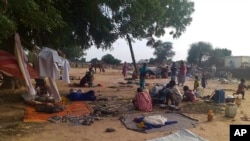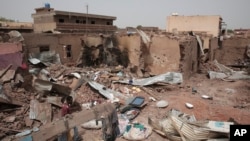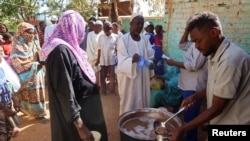The International Organization for Migration warns that the number of internally displaced people in Sudan soon will top 10 million, as conflict and acute hunger spread throughout the country.
Mohammed Refaat, the IOM’s chief of mission in Sudan, calls the crisis unfolding in Sudan a “catastrophic human tragedy.” He told journalists in Geneva on Friday that he was speaking from Port Sudan “with a heavy heart and a profound sense of urgency.”
“Today, I am not just a representative of a U.N. agency, I am a voice for millions of Sudanese whose lives have been forever altered by the ongoing crisis. Families have been torn apart, communities devastated, and the future put on hold. The human toll of this crisis is huge,” he said.
The IOM says that more than half of the 9.9 million people displaced inside Sudan are women and more than a quarter are children. Additionally, it says more than 2 million people have fled as refugees into neighboring countries, mainly to Chad, South Sudan, and Egypt.
Refaat observed that before rival generals of the Sudanese Armed Forces and paramilitary Rapid Support Forces went to war in mid-April 2023, displacement was largely concentrated within Darfur and Kordofan states. Since then, he said displacement has spread widely across all 18 states, with the majority, 36 percent, from the capital, Khartoum.
He said that 70 percent of people uprooted from their homes are trying to survive “in areas at risk of famine,” noting that most of those places are in the Darfur region, “which is currently the most difficult for humanitarians to reach.”
“The humanitarian situation has entered a new and alarming chapter, the outbreak of fighting in Al Fasher, the capital of North Darfur, putting over 800,000 civilians at risk,” he said. “Movement restrictions are choking the lifelines of those in the state, with crucial roads out of Al Fasher blocked and preventing civilians from reaching safer areas and limiting the amount of food and humanitarian aid coming into the city,”
The Food and Agriculture Organization and World Food Program issued a joint report on 18 world “hunger hotspots” Thursday in which they cite Sudan, along with Mali, Palestine, and South Sudan, as countries that “remain at the highest alert, and require the most urgent attention” to prevent famine.
According to the report, “18 million people are acutely food insecure, including 3.6 million children acutely malnourished, and famine is rapidly closing in on millions of people in Darfur, Kordofan, Al Jazirah, and Khartoum.”
“Conflict and displacement also continue at an alarming pace and magnitude in Sudan, where time is running out to save lives and the lean season looms,” the report warns.
Sudan historically has been a major transit and destination country for migrants. It traditionally has been a haven for many fleeing war, hunger and hardship from neighboring countries.
The IOM’s Refaat notes that the recent war has exacerbated the situation, however, “leaving many migrants and refugees stranded with limited access to support and services.”
Meanwhile, the World Health Organization warns that the health system in Sudan is collapsing. It notes about 65 percent of the Sudanese population lacks access to health care, just 25 percent of needed medical supplies are available and “only 20 to 30 percent of health facilities remain functional, at minimal levels” in hard-to-reach areas.
“At least two-thirds of the states are experiencing simultaneous outbreaks,” said WHO spokesperson Christian Lindmeier, noting that vaccination for measles has declined “due to the conflict.”
“Over 11,000 cases of cholera have been reported from 12 states and this is likely to be an underestimate, and there are also outbreaks of malaria and dengue,” he said, adding that many people are suffering from mental health, non-communicable and chronic diseases, including diabetes, hypertension, heart disease, and kidney failure for lack of treatment.
The IOM says that the prices of food, water and fuel are skyrocketing, making those essential goods unaffordable. This, at a time when “the world’s worst internal displacement crisis continues to escalate, with looming famine and disease adding to the havoc wrought by conflict,” it said in a statement Thursday.
Refaat said, “Aid agencies have struggled to keep pace with the growing needs. Funding shortfalls are impeding efforts to provide adequate shelter, food, and medical assistance.”
“Serious concerns are mounting about the long-term impact of the displacement on Sudan’s social and economic fabric,” he said, emphasizing that the IOM’s $312.5 million appeal to provide aid for 1.7 million people this year is only 19 percent funded.


